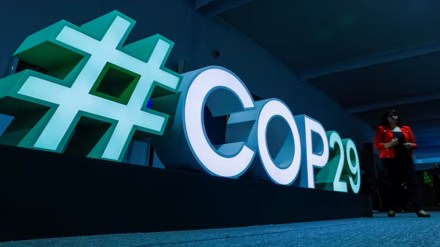As the 12-day Conference of the Parties (COP29) gets close to its mid-point at Baku, Azerbaijan, much is being made out of India’s low-key presence at such an important global event. A practical understanding of the same is that India continues to walk a tightrope. As the world ponders moving to greener energy pastures, India cannot do so just yet, as a growing population also demands more energy, which simply cannot be provided with green sources at present. India has already made its stand on the issue clear by stating that its goals will be prioritising accountability, green credit initiatives, fair financing, and achievable climate goals for developing economies.
COP29 sees two major aspects in its background — the re-election of Donald Trump, whose administration infamously pulled out of the Paris Accord in 2017 and who proudly embraces the motto “Drill, baby, drill”; and China’s increasing dominance over the deployment of renewable energy. While the US climate envoy John Podesta assured that Trump’s victory “is not the end of our fight for a cleaner, safer planet”, the US has historically under-delivered on its international climate programmes. As for China, while its contributions to deploy renewable energy technology are significant, its motives can be termed questionable, as was visible on day 1 when it submitted a proposal to discuss the European Union’s Carbon Border Adjustment Mechanism (CBAM), which held back COP29’s agenda for a while.
Overall, developed nations have failed to deliver on the $100 billion a year contribution decided in 2009. The lack of a formal agreement among the contributors as well as clarification on who will hand out how much has contributed to the inaction that COPs have gained infamy for. The New Quantified Collective Goal, the replacement of the $100 billion contribution, is anticipated this year. Experts have estimated that it needs to be at $2.4 trillion to combat rising temperatures, but with COP’s historic inefficiency, it remains unclear.
As for India, it is at a unique position of being the third-biggest emitter after China and the US (8% of global emissions), but it is also at the receiving end of climate development funds, as it is still a developing country. To its credit, the Centre has managed to achieve two targets of the nationally determined contributions ahead of time — as of 2023, the emissions intensity of its GDP was reduced by 33% (target being 30-35%), and 43.81% of its cumulative electric power installed capacity came from non-fossil fuel-based energy. The targets have been subsequently updated for 2030. However, India remains the third-largest emitter based on the sheer size of its population and industry, and phasing out fossil fuels will be secondary to catering to the energy needs of the nation.
Combating rising temperatures is not up to two superpowers alone. However, global leaders have been seen to lack the urgency to commit to net zero transitions as the effects of climate change become glaringly obvious. Developing countries also need to play their part. For the sake of our future, it is hoped that COP29 should be able to agree to a mechanism which uses market-based instruments such as carbon credits to incentivise low-carbon development. As Arunabha Ghosh, CEO of the Council on Energy, Environment and Water, has said, COP29 should raise both the quantum and quality of climate finance. The question is not just how much is needed, but how reliably it will be delivered.
